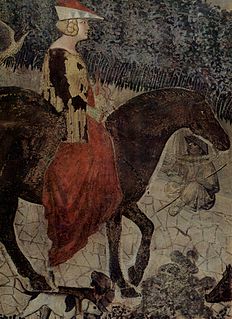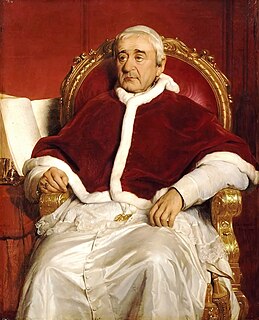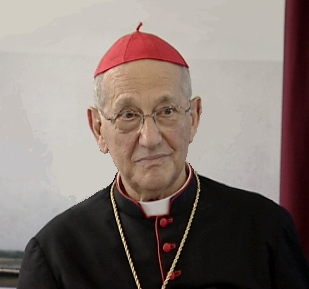 W
WGiacomo Antonelli was an Italian cardinal deacon. He was the Cardinal Secretary of State from 1848 until his death; he played a key role in Italian politics, resisting the unification of Italy and affecting Roman Catholic interests in European affairs. He was often called the "Italian Richelieu" and the "Red Pope."
 W
WAntoninus of Florence, was an Italian Dominican friar, who ruled as an archbishop of Florence. He is venerated as a saint by the Catholic Church.
 W
WArnold of Brescia, also known as Arnaldus, was an Italian canon regular from Lombardy. He called on the Church to renounce property ownership and participated in the failed Commune of Rome.
 W
WThe Avignon Exchange was one of the first foreign exchange markets in history, established in the Comtat Venaissin during the Avignon Papacy. The Exchange was composed of the agents (factores) of the great Italian banking-houses, who acted as money-changers as well as financial intermediaries between the Apostolic Camera and its debtors and creditors. The most prosperous quarter of the city of Avignon, where the bankers settled, became known simply as the Exchange. According to de Roover, "Avignon can be considered an Italian colony, since the papal bankers were all Italians".
 W
WThe Bank of the Holy Spirit was a bank founded by Pope Paul V on December 13, 1605. The bank was the first national bank in Europe, the first public deposit bank in Rome, and the oldest continuously operating bank in Rome until its merger in 1992.
 W
WBernardine of Feltre was a Friar Minor and missionary, b. at Feltre, Italy, in 1439 and d. at Pavia, 28 September 1494. He is remembered in connection with the monti di pietà of which he was the reorganizer and, in a certain sense, the founder, together with the Michele Carcano. The feast of Blessed Bernardino is kept in the Order of Friars Minor on 28 September.
 W
WBernardino of Siena was an Italian priest and Franciscan missionary. He was a systematizer of Scholastic economics. His popular preaching made him famous during his own lifetime because it was frequently directed against sorcery, gambling, infanticide, witchcraft, homosexuality, Jews, and usury. Bernardino was later canonised by the Catholic Church as a saint – where he is also referred to as "the Apostle of Italy" – for his efforts to revive the country's Catholic faith during the 15th century.
 W
WOrlando Bonsignori was an Italian banker from Siena.
 W
WNicola Canali was an Italian Cardinal of the Roman Catholic Church. He served as President of the Pontifical Commission for Vatican City State from 1939 and as Major Penitentiary from 1941 until his death, and was elevated to the cardinalate in 1935. He was Grand Master of the Order of the Holy Sepulchre of Jerusalem, a prestigious papal order of knighthood.
 W
WGiuseppe Caprio, was an Italian cardinal of the Roman Catholic Church. He held the post of President of the Prefecture for the Economic Affairs of the Holy See before he retired in 1990. He had been the internuncio, then pro-nuncio, to China from 1959–1967, and the pro-nuncio to India from 1967–1969.
 W
WCem Sultan or Sultan Cem, was a claimant to the Ottoman throne in the 15th century.
 W
WDuring the Middle Ages, the Gran Tavola was the largest Sienese bank; it was one of the most powerful banks in Europe from 1255 to 1298. The Gran Tavola has been called "the greatest bank of the thirteenth century" as well as "one of the largest commercial and banking enterprises in Europe".
 W
WSergio Guerri was an Italian Cardinal of the Roman Catholic Church who served as personal theologian to five popes from 1955 to 1989, and was elevated to the cardinalate in 1969.
 W
WAlberto di Jorio was a cardinal of the Catholic Church and for many years along with the layman Bernardino Nogara the powerhouse behind the growing wealth of the Vatican and the Istituto per le Opere di Religione.
 W
WThe Liber Censuum Romanæ Ecclesiæ is an eighteen-volume (originally) financial record of the real estate revenues of the papacy from 492 to 1192. The span of the record includes the creation of the Apostolic Camera and the effects of the Gregorian Reform. The work constitutes the "latest and most authoritative of a series of attempts, starting in the eleventh century, to keep an accurate record of the financial claims of the Roman church". According to historian J. Rousset de Pina, the book was "the most effective instrument and [...] the most significant document of ecclesiastical centralization" in the central Middle Ages.
 W
WPaul Marcinkus, GCOIH was an American archbishop of the Roman Catholic Church and president of the Vatican Bank from 1971 to 1989.
 W
WA mount of piety is an institutional pawnbroker run as a charity in Europe from Renaissance times until today. Similar institutions were established in the colonies of Catholic countries; the Mexican Nacional Monte de Piedad is still in operation.
 W
WPierre de Murat de Cros, O.S.B., was a French monk of aristocratic origins who became a cardinal of the Avignon Obedience during the Great Schism, as well as the Archbishop of Arles and the Chamberlain of the Apostolic Camera. Refusing from the day of his election to support Bartolomeo Prignano after the Papal Conclave of 1378, de Cros played a critical role in delivering a considerable portion of the Roman Curia to the rival claimant Robert of Geneva, who took the name Clement VII. Historian Daniel Williman calls Murat de Cros's actions a "counter-coup".
 W
WBernardino Nogara was the financial advisor to the Vatican between 1929 and 1954, appointed by Pope Pius XI and retained by Pope Pius XII as the first Director of the Special Administration of the Holy See. According to historian John F. Pollard, Nogara laid "the foundations" for "one of the biggest pillars for the Vatican's post-Second World War financial strength."
 W
WErnesto Pacelli was a financial adviser to Pope Leo XIII, Pope Pius X, and Pope Benedict XV and the founder and president of the Banco di Roma from March 9, 1880 until 1916. Pacelli also served as an unofficial link between the Vatican and the Italian government. Papal historian John Pollard calls him the "first of the great laymen to be associated with the finances of the Holy See."
 W
WPapal income tax was first leveled in 1199 by Pope Innocent III, originally requiring all Catholic clergy to pay one-fortieth of their ecclesiastical income annually in support of the Crusades. The second income tax was not levied until the Fourth Lateran Council in 1215, and constituted only a triennial twentieth.
 W
WThe Peruzzi were bankers of Florence, among the leading families of the city in the 14th century, before the rise to prominence of the Medici. Their modest antecedents stretched back to the mid 11th century, according to the family's genealogist Luigi Passerini, but a restructuring of the Peruzzi company in 1300, with an infusion of outside capital, marked the start of a quarter-century of prosperity that brought the family consortium to the forefront of Florentine affairs.
 W
WPeter's Pence are donations or payments made directly to the Holy See of the Catholic Church. The practice began under the Saxons in England and spread through Europe. Both before and after the Norman conquest the practice varied by time and place; initially, it was done as a pious contribution, whereas later it was required by various rulers, and collected, more like a tax. Though formally discontinued in England at the time of the Reformation, a post-Reformation payment of uncertain characteristics is seen in some English manors into the 19th century. In 1871, Pope Pius IX formalized the practice of lay members of the church and "other persons of good will" providing financial support to the Roman See. Modern "Peter's Pence" proceeds are used by the Pope for philanthropic works throughout the world and for administrative costs of the Vatican state.
 W
WRaymond of Penyafort, OP, was a Catalan Dominican friar in the 13th century, who compiled the Decretals of Gregory IX, a collection of canonical laws that remained a major part of Church law until the 1917 Code of Canon Law abrogated it. He is honored as a saint in the Catholic Church and is the patron saint of canon lawyers.
 W
WRothschild loans to the Holy See refers to a series of major financial loans arranged between the Rothschild family and the Holy See of the Catholic Church. The first loan which occurred in 1832 took place in the aftermath of the Napoleonic Wars during the Pontificate of Pope Gregory XVI. This loan agreed on was for a sum of £400,000. A second loan occurred during the Pontificate of Pope Pius IX in the early 1850s with the same members of the Rothschild family after the collapse of Giuseppe Mazzini's short-lived revolutionary Roman Republic and the restoration of the Papal States.
 W
WSergio Sebastiani is an Italian prelate of the Catholic Church who was head of the Prefecture for the Economic Affairs of the Holy See from 1997 to 2008. He was made a cardinal in 2001. From 1960 to 1994 he worked in the diplomatic service of the Holy See, becoming an archbishop and apostolic nuncio in 1976 and leading the offices representing the Vatican in Madagascar, Mauritius, and Turkey.
 W
WThe English statute usually called Statute of Provisors is the 25th of Edward III, St. 4 (1350–51), otherwise termed "The Statute of Provisors of Benefices", or anciently De provisoribus. This measure was central to a long disagreement between the English kings and the Roman Curia, concerning filling of ecclesiastical benefices.
 W
WThe Statutes of Mortmain were two enactments, in 1279 and 1290, passed in the reign of Edward I of England, aimed at preserving the kingdom's revenues by preventing land from passing into the possession of the Church. Possession of property by a corporation, such as the Church, was known as mortmain, which literally meant "dead hand". In medieval England, feudal estates generated taxes for the King, principally on the grant or inheritance of the estate. If an estate became owned by a religious corporation which could never die, could never attain majority, and could never be attainted for treason, these taxes never became payable. It was akin to the estates being owned by the dead, hence the term.
 W
WEdmund Casimir Szoka was an American prelate of the Roman Catholic Church. He was President of the Pontifical Commission for Vatican City State and President of the Governorate of Vatican City State, having previously served as Bishop of Gaylord from 1971 to 1981 and Archbishop of Detroit from 1981 to 1990. Szoka was elevated to the cardinalate in 1988.
 W
WEgidio Vagnozzi was an Italian Cardinal of the Catholic Church. He served as the second president of the Prefecture for the Economic Affairs of the Holy See from 1968 until his death, and was elevated to the cardinalate in 1967.
 W
WThe vestararius was the manager of the medieval Roman Curia office of the vestiarium, responsible for the management of papal finances as well as the papal wardrobe. The vestiarium is mentioned as the papal treasury as early as the seventh century, during the period of Byzantine cultural hegemony in the West called the "Byzantine Papacy", but the vestararius itself is attested to only from the eighth century.